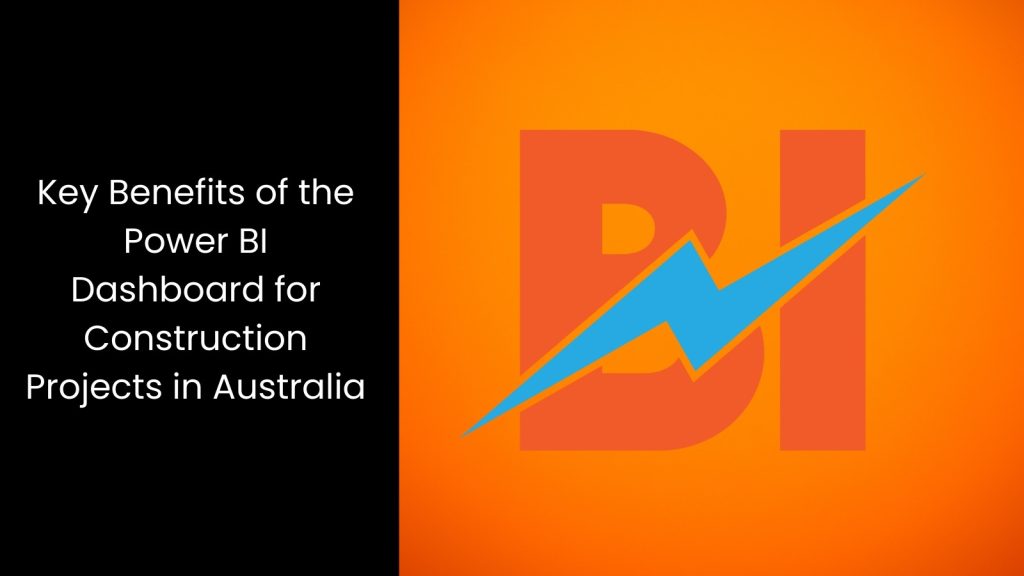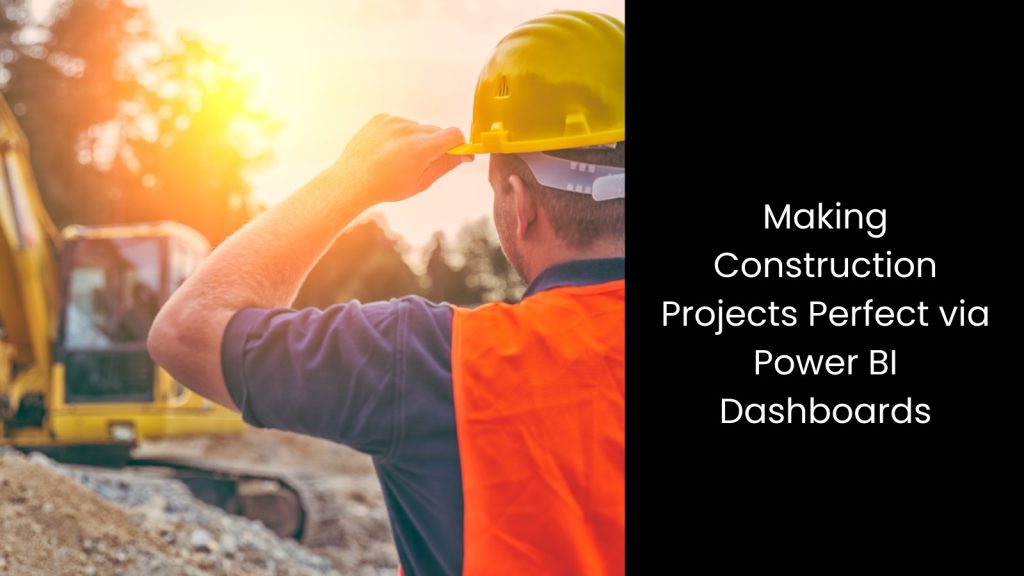According to the reports from the recent past, it was revealed that Victoria is the strongest performing state for construction work in Australia, followed by Tasmania in the second place and South Australia and New South Wales in the third and fourth places, respectively. So, as it is visible, Australia as a country puts a lot of weight on construction projects, as they clearly know it is a sign of development. However, if we consider recent years, a new tool is poised to revolutionise project management and efficiency when it comes to the construction industry. The ‘Power BI dashboard’, known as a cutting-edge data visualisation platform, is rapidly gaining traction among construction firms across the nation.
This article will reveal everything about Power BI dashboards and the benefits of construction perfection in Australia.
This article will reveal everything about Power BI dashboards and the benefits of construction perfection in Australia.
Explaining Power BI Dashboards

- These are the sort of dashboards that serve as powerful tools that allow businesses and project teams to visualise and analyse data in a way that makes complex information easy to understand. These dashboards work by pulling data from various sources, such as databases, spreadsheets, and cloud services, and displaying it all in one place.
- This data consolidation helps users quickly spot trends, track progress, and make informed decisions. When it comes to construction projects, for instance, project managers use Power BI dashboards to monitor timelines, budgets, and resources in real-time. They can see how a project is progressing against its plan, identify any delays, and take immediate action to keep things on track.
- The best feature about them is that they are highly customisable. It allows users to create specific reports that focus on the key metrics that matter most to their roles. The ability to visualise data in charts, graphs, and other formats makes it easier for everyone involved in a project to understand complex data at a glance. This enhanced visibility creates better collaboration among team members, as they all work from the same data set and can discuss issues with a shared understanding.
- Another important fact is that, just like any other software tool, these dashboards can stand alone or be embedded into another technology.
Key Benefits of the Power BI Dashboard for Construction Projects in Australia

Predictive Analytics
Receiving powerful predictions is an invaluable factor in construction projects in Australia because it allows project managers to foresee potential issues and opportunities. This capacity certainly helps them to make informed decisions that keep projects on track.
You know that in construction, unexpected delays, cost overruns, or resource shortages can derail a project, leading to significant financial and reputational losses. Traditional methods of predicting project outcomes often rely on manual calculations, experience-based estimates, and static reports, which can be time-consuming and prone to errors. These methods cannot quickly adapt to changing conditions, making it difficult to accurately forecast risks and opportunities.
This is where Power BI dashboards come in as a topper. As it can analyse historical data, Power BI can help forecast potential project risks and opportunities. The latter allows proactive management and risk mitigation. This predictive analytics capability allows construction managers to anticipate problems before they occur and take corrective action to avoid costly setbacks.
You know that in construction, unexpected delays, cost overruns, or resource shortages can derail a project, leading to significant financial and reputational losses. Traditional methods of predicting project outcomes often rely on manual calculations, experience-based estimates, and static reports, which can be time-consuming and prone to errors. These methods cannot quickly adapt to changing conditions, making it difficult to accurately forecast risks and opportunities.
This is where Power BI dashboards come in as a topper. As it can analyse historical data, Power BI can help forecast potential project risks and opportunities. The latter allows proactive management and risk mitigation. This predictive analytics capability allows construction managers to anticipate problems before they occur and take corrective action to avoid costly setbacks.
Centralised Data Management
It is common knowledge that construction projects in general generate data from various sources, such as financial reports, timelines, resource management tools, and on-site sensors. Traditionally, managing this data can be overwhelming. As they come with information scattered across different platforms, it makes it difficult for project managers to get a clear, comprehensive view of the project’s status.
However, this is where Power BI addresses this challenge by consolidating data from various sources into a single platform, making it easier to manage, access, and analyse project information. This centralisation of data allows construction teams to quickly pull insights from multiple aspects of a project without needing to switch between different tools or manually combine data sets.
For example, financial data, scheduling updates, and workforce management information can all come under one screen, giving a complete picture of how the project is progressing. The mechanism behind this lies in Power BI’s ability to connect to various data sources, whether they are cloud-based, on-premises, or even from third-party applications. Once connected, Power BI automatically updates the data in real time, ensuring that the dashboard reflects the most current information. This real-time integration becomes especially important in the fast-paced environment of construction projects, where delays or miscommunications can lead to significant issues.
However, this is where Power BI addresses this challenge by consolidating data from various sources into a single platform, making it easier to manage, access, and analyse project information. This centralisation of data allows construction teams to quickly pull insights from multiple aspects of a project without needing to switch between different tools or manually combine data sets.
For example, financial data, scheduling updates, and workforce management information can all come under one screen, giving a complete picture of how the project is progressing. The mechanism behind this lies in Power BI’s ability to connect to various data sources, whether they are cloud-based, on-premises, or even from third-party applications. Once connected, Power BI automatically updates the data in real time, ensuring that the dashboard reflects the most current information. This real-time integration becomes especially important in the fast-paced environment of construction projects, where delays or miscommunications can lead to significant issues.
Customisable Reports
If you are from the Australian construction industry, who knows better than you that this particular field requires numerous report types? This is mainly because each project involves a wide range of activities, stakeholders, and goals that demand different types of information.
For instance, project managers need reports on timelines and resource allocation to ensure everything stays on schedule and within budget, while financial officers focus on cost management and budget variance. Likewise, safety officers require detailed reports on incidents and compliance with regulations, while engineers and architects need updates on design changes and material usage. The ability to create custom reports tailored to specific project needs allows stakeholders to focus on key metrics and insights relevant to their roles.
This is made easier with Power BI dashboards, as they provide a significant advantage in this regard by offering customisable reports that can be designed to meet the unique requirements of each role within a construction project. For example, a project manager might generate a report that tracks progress against milestones, while a safety officer might focus on incidents and safety compliance.
Power BI is enriched with the ability to consolidate data from various sources into a single platform. Not to mention that this capability makes it easier to manage, access, and analyse project information. Once the data is centralised, users can create custom reports by selecting the specific data points, charts, and visualisations that are most relevant to their needs. These reports can then be updated in real-time, ensuring that all stakeholders have access to the most current information.
For instance, project managers need reports on timelines and resource allocation to ensure everything stays on schedule and within budget, while financial officers focus on cost management and budget variance. Likewise, safety officers require detailed reports on incidents and compliance with regulations, while engineers and architects need updates on design changes and material usage. The ability to create custom reports tailored to specific project needs allows stakeholders to focus on key metrics and insights relevant to their roles.
This is made easier with Power BI dashboards, as they provide a significant advantage in this regard by offering customisable reports that can be designed to meet the unique requirements of each role within a construction project. For example, a project manager might generate a report that tracks progress against milestones, while a safety officer might focus on incidents and safety compliance.
Power BI is enriched with the ability to consolidate data from various sources into a single platform. Not to mention that this capability makes it easier to manage, access, and analyse project information. Once the data is centralised, users can create custom reports by selecting the specific data points, charts, and visualisations that are most relevant to their needs. These reports can then be updated in real-time, ensuring that all stakeholders have access to the most current information.
Data Visualisation in Real Time
When it comes to construction, especially in Australia, conditions can change rapidly, whether due to weather, supply chain disruptions, or unexpected site issues. These changes demand immediate attention and action to keep the project on track.
Power BI dashboards allow construction teams to visualise project data in real time. It enables faster decision-making and response to project needs. How this occurs is interesting to explore. Power BI can indeed connect to various data sources, such as project management software, financial systems, and on-site sensors.
Once connected, Power BI continuously updates the data, reflecting any changes or new information instantly on the dashboard. This real-time data visualisation means that project managers can see the most current status of a project at any given moment, whether it is tracking the progress of tasks, monitoring budget expenditures, or checking on resource availability.
For example, if a delay occurs due to a supply chain issue, the dashboard immediately reflects this, allowing the team to assess the impact and make adjustments, such as reallocating resources or adjusting timelines. This capability reduces the lag time between when an issue arises and when it is addressed, leading to more efficient project management.
Power BI dashboards allow construction teams to visualise project data in real time. It enables faster decision-making and response to project needs. How this occurs is interesting to explore. Power BI can indeed connect to various data sources, such as project management software, financial systems, and on-site sensors.
Once connected, Power BI continuously updates the data, reflecting any changes or new information instantly on the dashboard. This real-time data visualisation means that project managers can see the most current status of a project at any given moment, whether it is tracking the progress of tasks, monitoring budget expenditures, or checking on resource availability.
For example, if a delay occurs due to a supply chain issue, the dashboard immediately reflects this, allowing the team to assess the impact and make adjustments, such as reallocating resources or adjusting timelines. This capability reduces the lag time between when an issue arises and when it is addressed, leading to more efficient project management.
Making Construction Projects Perfect via Power BI Dashboards

If you have read the whole article, you already know that achieving perfection in construction projects becomes attainable with these Power BI dashboards, as they help you manage projects with unparalleled precision. The wisest decision you can make is to invest in a software solution with embedded Power BI dashboards to transform your construction processes and consistently deliver top-quality results on time and within budget. Reliable software collaboration is a must here.







